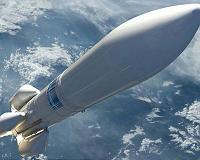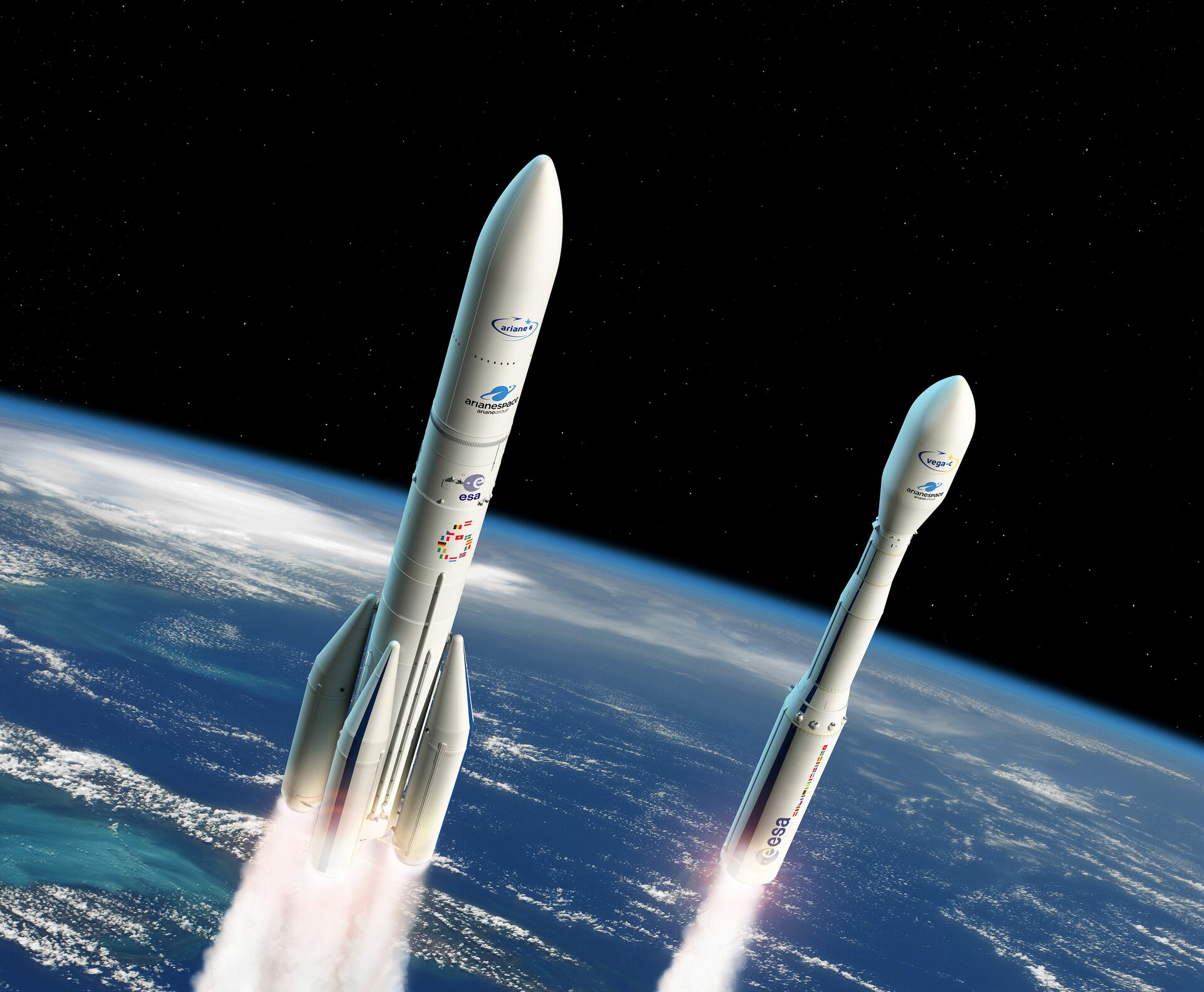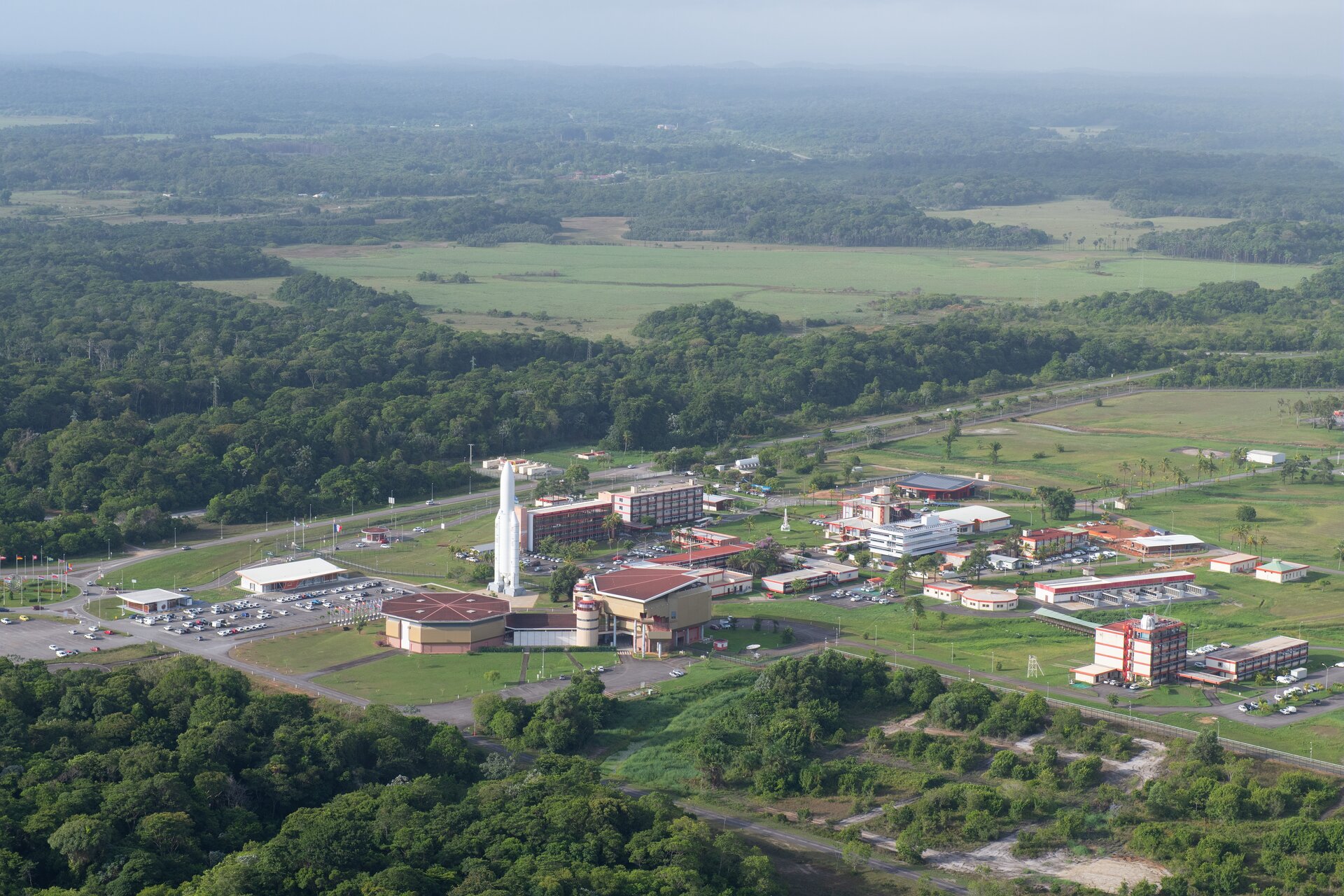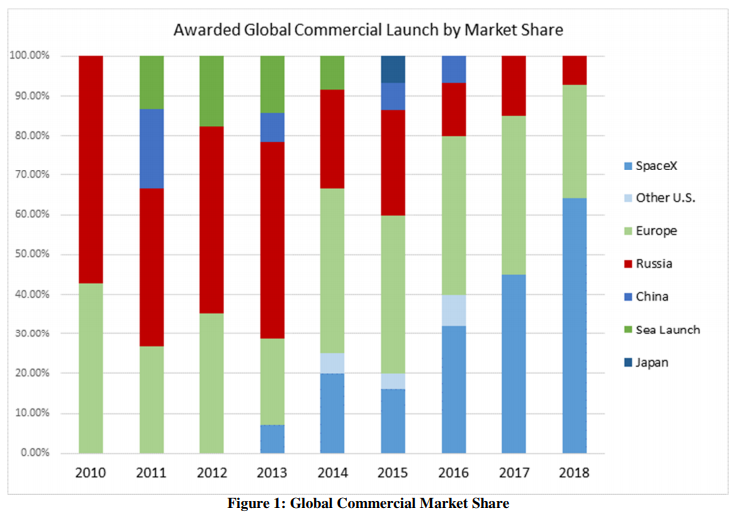You are using an out of date browser. It may not display this or other websites correctly.
You should upgrade or use an alternative browser.
You should upgrade or use an alternative browser.
ESA Ariane 6
- Thread starter Grey Havoc
- Start date
- Joined
- 21 January 2015
- Messages
- 12,156
- Reaction score
- 16,372
- Joined
- 21 January 2015
- Messages
- 12,156
- Reaction score
- 16,372
I can see Ariane 6 having a comparatively short life.Sort of. Callisto is a testbed. It's one of the steps on the road to Ariane 7, but not its final shape.
- Joined
- 9 October 2009
- Messages
- 21,976
- Reaction score
- 13,638

ESA and European Commission preorder four more Ariane 6 launches
Evry, France (SPX) Mar 11, 2020 - Arianespace told SpaceDaily that it has received a preorder from the European Space Agency (ESA), on behalf of the European Commission (DG Grow), for four launches using the Ariane 6 rocket. Planned
www.spacedaily.com
FighterJock
ACCESS: Above Top Secret
- Joined
- 29 October 2007
- Messages
- 5,609
- Reaction score
- 5,941
I do hope that Ariane 7 is going to be a heavy booster to lift a manned capsule to the Moon then Mars, Arianespace really need a competitor to the SLS and the next generation Chinese Long March heavy rocket.
Deltafan
ACCESS: Top Secret
- Joined
- 8 May 2006
- Messages
- 1,697
- Reaction score
- 2,318
I hope too...I do hope that Ariane 7 is going to be a heavy booster to lift a manned capsule to the Moon then Mars, Arianespace really need a competitor to the SLS and the next generation Chinese Long March heavy rocket.
But…
Since the cancellation of the Hermes Space Shuttle by EU, some years ago, Europe's space ambitions seem to me as unpredictable as it is uncertain...
Ariane 7 is already being worked on (under the name Ariane Next). This will be a reusable replacement for Ariane 6, in the same payload class. There are no plans to develop a larger rocket at the moment.
FighterJock
ACCESS: Above Top Secret
- Joined
- 29 October 2007
- Messages
- 5,609
- Reaction score
- 5,941
Ariane 7 is already being worked on (under the name Ariane Next). This will be a reusable replacement for Ariane 6, in the same payload class. There are no plans to develop a larger rocket at the moment.
Europe dragging its heals over large rocket development as usual.
Europe is developing rockets according to its requirements.
Not my concern but don't "needs" drive "requirements"? The issue comes down to who defines them and why. In terms of SLS, the "needs" were pork and the "requirements" were whatever fits the bill. It will be interesting to see how Europe decides these things.
- Joined
- 9 October 2009
- Messages
- 21,976
- Reaction score
- 13,638
I should note that Ariane 5 production has yet to conclude.
FighterJock
ACCESS: Above Top Secret
- Joined
- 29 October 2007
- Messages
- 5,609
- Reaction score
- 5,941
I should note that Ariane 5 production has yet to conclude.
When is Ariane 5 production stopping Grey Havoc? I thought that the last launch was to be the James Webb Space Telescope?
- Joined
- 9 October 2009
- Messages
- 21,976
- Reaction score
- 13,638
Originally it was supposed to be around 2023 if I'm not mistaken, though there is circumstantial evidence some more examples may be added to the last ordered batch (PC Batch) of ten launch vehicles, which was originally ordered back in early 2018 (the first of which is scheduled to be launched this year). This meant as of January 2018 there were 23 Ariane 5s still in production or on order.
- Joined
- 21 January 2015
- Messages
- 12,156
- Reaction score
- 16,372
It is rocket science: EU to speed up space ambitions, Breton says
The European Union will plough more money into rocket launches, satellite communication and space exploration to preserve its often unsung successes in space and keep up with US and Chinese ambitions, its space chief said on Sunday.
European Commissioner Thierry Breton:
SpaceX has redefined the standards for launchers, so Ariane 6 is a necessary step, but not the ultimate aim: we must start thinking now about Ariane 7
- Joined
- 21 January 2015
- Messages
- 12,156
- Reaction score
- 16,372

ESA lays out roadmap to Vega-C and Ariane 6 flights
Vega-C and Ariane 6 are being developed by ESA to assure Europe’s independent access to space. The maiden flight for Vega-C is planned to take place in June 2021, and that for Ariane 6 in the second quarter of 2022.
www.esa.int
- Joined
- 13 August 2007
- Messages
- 8,451
- Reaction score
- 11,024
news Arianespace and ESA sign contract for Themis program

 www.ariane.group
www.ariane.group
Goal for Reusable Ariane in year 2030.
ehh 2030 ?
View: https://www.youtube.com/watch?v=4EoAHdwGBvU

ArianeGroup signs contract with ESA to develop Themis reusable stage demonstrator - ArianeGroup
The European Space Agency (ESA) has awarded ArianeGroup the contract for the initial development phase of the Themis reusable rocket stage demonstrator This first contract, worth 33 million euros, was awarded to ArianeGroup following preparatory work done by ArianeWorks, the innovation...
Goal for Reusable Ariane in year 2030.
ehh 2030 ?
- Joined
- 3 June 2011
- Messages
- 18,339
- Reaction score
- 12,242
news Arianespace and ESA sign contract for Themis program

ArianeGroup signs contract with ESA to develop Themis reusable stage demonstrator - ArianeGroup
The European Space Agency (ESA) has awarded ArianeGroup the contract for the initial development phase of the Themis reusable rocket stage demonstrator This first contract, worth 33 million euros, was awarded to ArianeGroup following preparatory work done by ArianeWorks, the innovation...www.ariane.group
Goal for Reusable Ariane in year 2030.
ehh 2030 ?
View: https://www.youtube.com/watch?v=4EoAHdwGBvU
They sure are aiming low. Starship will be fully reusable and flying regularly by 2030. Probably New Armstrong as well.
- Joined
- 13 August 2007
- Messages
- 8,451
- Reaction score
- 11,024
in 2030
the Starship Fleet is operational
also New Armstrong (while they build bigger rocket named after the guy who put his feet on Mars)
The Chinese and India will there reusable Rocket ships
Also Ethiopia...
Welcome to future ESA...
the Starship Fleet is operational
also New Armstrong (while they build bigger rocket named after the guy who put his feet on Mars)
The Chinese and India will there reusable Rocket ships
Also Ethiopia...
Welcome to future ESA...
in 2030
the Starship Fleet is operational
also New Armstrong (while they build bigger rocket named after the guy who put his feet on Mars)
The Chinese and India will there reusable Rocket ships
Also Ethiopia...
Welcome to future ESA...
Can't rush these things.........
- Joined
- 13 August 2007
- Messages
- 8,451
- Reaction score
- 11,024
The SpaceX reusable launch system development programCan't rush these things.........
Took around 5 years until first landing of Booster on 22 December 2015
ArianeSpace could have a reusable Ariane 7 in 2025
But you know Politic, the ministers Idiots who are ESA decision maker,
Think to protect the European Aerospace industry by building the disposable launcher Ariane 6.
There opinions is that reusability destroy jobs
odd, SpaceX use reusable rockets and has engagement of personnel
- Joined
- 27 May 2008
- Messages
- 1,179
- Reaction score
- 2,485
5 years ? It’s taken the Arianespace/ESA gravy train 7-8 years to do a simple rehash of yesterday’s technology ie Ariane 6. For something genuinely new, with the ingrained risk adversity it will take ten years plus. So when they fire the first ignitor for real, they’ll be 15 plus years behind SpaceX. I do wonder what Ariane 6 will be launching in the meantime? I can’t see any Sat builders being particularly keen to commission a flight...... unless the EU give em for free.
Also I love looking back at those ESA seniors claiming Space X would never make it and the future would be expendable’s.... Tomorrow’s EU taxes paying for yesterday’s technology.
Also I love looking back at those ESA seniors claiming Space X would never make it and the future would be expendable’s.... Tomorrow’s EU taxes paying for yesterday’s technology.
- Joined
- 3 June 2011
- Messages
- 18,339
- Reaction score
- 12,242
The first time they try to land one and it crashes they'll retire it. "Too risky."5 years ? It’s taken the Arianespace/ESA gravy train 7-8 years to do a simple rehash of yesterday’s technology ie Ariane 6. For something genuinely new, with the ingrained risk adversity it will take ten years plus. So when they fire the first ignitor for real, they’ll be 15 plus years behind SpaceX. I do wonder what Ariane 6 will be launching in the meantime? I can’t see any Sat builders being particularly keen to commission a flight...... unless the EU give em for free.
Also I love looking back at those ESA seniors claiming Space X would never make it and the future would be expendable’s.... Tomorrow’s EU taxes paying for yesterday’s technology.
- Joined
- 21 January 2015
- Messages
- 12,156
- Reaction score
- 16,372
Rather than start a separate thread for this it seems more logical to put it here as this will partly be in service of supporting Ariane 6 launches as well as Vega-C.


ESA and CNES sign contract to maintain and modernise Spaceport
ESA will contribute to the maintenance, operations and modernisation of Europe’s Spaceport in Kourou, French Guiana over the period 2020–24.
www.esa.int
- Joined
- 21 January 2015
- Messages
- 12,156
- Reaction score
- 16,372
Both of these are irrelevant as the goal of Ariane has always been partly to maintain independent access to space. So what the US does or doesn’t do it will never be given certain European payloads as these will be for European launchers alone even if that means paying more. Ariane is greatly driven by France who have no desire to become reliant on the US in this area I suspect.news Arianespace and ESA sign contract for Themis program

ArianeGroup signs contract with ESA to develop Themis reusable stage demonstrator - ArianeGroup
The European Space Agency (ESA) has awarded ArianeGroup the contract for the initial development phase of the Themis reusable rocket stage demonstrator This first contract, worth 33 million euros, was awarded to ArianeGroup following preparatory work done by ArianeWorks, the innovation...www.ariane.group
Goal for Reusable Ariane in year 2030.
ehh 2030 ?
View: https://www.youtube.com/watch?v=4EoAHdwGBvU
They sure are aiming low. Starship will be fully reusable and flying regularly by 2030. Probably New Armstrong as well.
martinbayer
ACCESS: Top Secret
- Joined
- 6 January 2009
- Messages
- 3,397
- Reaction score
- 3,906
Rightly so - the US bait and switch promise of "free" Scout launches for the UK, which at least in part led to the cancellation of the Black Arrow, see https://en.wikipedia.org/wiki/Black_Arrow, comes to mind.Both of these are irrelevant as the goal of Ariane has always been partly to maintain independent access to space. So what the US does or doesn’t do it will never be given certain European payloads as these will be for European launchers alone even if that means paying more. Ariane is greatly driven by France who have no desire to become reliant on the US in this area I suspect.
- Joined
- 3 June 2011
- Messages
- 18,339
- Reaction score
- 12,242
I would have thought they'd have been hoping to use commercial payloads to help defray the costs.Both of these are irrelevant as the goal of Ariane has always been partly to maintain independent access to space. So what the US does or doesn’t do it will never be given certain European payloads as these will be for European launchers alone even if that means paying more. Ariane is greatly driven by France who have no desire to become reliant on the US in this area I suspect.news Arianespace and ESA sign contract for Themis program

ArianeGroup signs contract with ESA to develop Themis reusable stage demonstrator - ArianeGroup
The European Space Agency (ESA) has awarded ArianeGroup the contract for the initial development phase of the Themis reusable rocket stage demonstrator This first contract, worth 33 million euros, was awarded to ArianeGroup following preparatory work done by ArianeWorks, the innovation...www.ariane.group
Goal for Reusable Ariane in year 2030.
ehh 2030 ?
View: https://www.youtube.com/watch?v=4EoAHdwGBvU
They sure are aiming low. Starship will be fully reusable and flying regularly by 2030. Probably New Armstrong as well.
- Joined
- 13 August 2007
- Messages
- 8,451
- Reaction score
- 11,024
Just little Infographic
What SpaceX has manage over years

What SpaceX has manage over years

- Joined
- 26 September 2008
- Messages
- 1,960
- Reaction score
- 746
Just little Infographic
What SpaceX has manage over years

You have to be careful with graphics like that, because they require context. For instance, often these charts include NASA launches as "commercial" because of the way the contracts are written. That means that a US government payload on a US launch vehicle (SpaceX) is counted as "commercial," whereas a European government payload on a European launch vehicle, or a Russian government payload on a Russian launch vehicle is not counted as commercial.
marauder2048
"I should really just relax"
- Joined
- 19 November 2013
- Messages
- 3,157
- Reaction score
- 926
I suppose with the ESA member states covering any losses, revenue is all you can look at.it also hides how many launches there were, so doesn't say anything about total revenue.
marauder2048
"I should really just relax"
- Joined
- 19 November 2013
- Messages
- 3,157
- Reaction score
- 926
But revenue could have declined for the commercial market as a whole due to competitionThat's not what I meant. When you hide the number of launches, you can't see if the market has grown or shrunk.
but be offset by the institutional launches whose definition is, per blackstar's point, squishy.
- Joined
- 26 September 2008
- Messages
- 1,960
- Reaction score
- 746
That's not what I meant. When you hide the number of launches, you can't see if the market has grown or shrunk.
Yeah, this is only showing percentages, not number of launches, and 100% of 60 is not the same as 100% of 80.
To really understand this subject, you need a bunch of different statistics. In general, there really was no US commercial launch market until about 5+ years ago. That's when SpaceX started taking away customers from Russia and Arianespace. A lot of SpaceX's growth has been at the detriment of those other non-US launch vehicles. So it would be useful to have percentages of the commercial launch market by country and show that over time (the above table shows some of that, but not exactly).
Personally, I would subtract-out the NASA and DoD launches that are book-kept as "commercial" from any comparison, because there is no way that those payloads are going to a non-US launch vehicle (NASA is not going to buy a launch on a Russian or European rocket); they're either going to ULA or SpaceX. But again, to really discuss this, you would need more charts and explanation.
Finally, I'd add that launch vehicles are really not the most important part of the "commercial" space sector. That's just a fraction. You'd also want to look at payloads (satellites) and services too. But it's common on the internet to focus on the rockets because rockets make noise and look cool.
- Joined
- 21 January 2015
- Messages
- 12,156
- Reaction score
- 16,372
Ariane 6 on the move.
View: https://mobile.twitter.com/DLR_de/status/1359188574084734978
View: https://mobile.twitter.com/DLR_de/status/1359188574084734978
One #Domblick, please! Star-struck Today the first upper stage of the launcher went across the Rhineland @ Ariane6 . The container with the valuable freight passed #Duesseldorf, #Koeln and #Bonn on the waterway - with the best view of the city's
